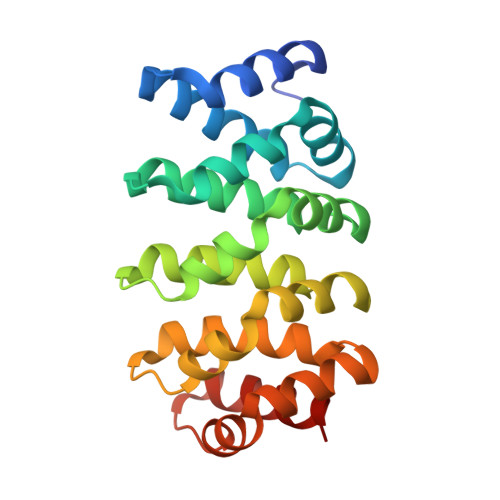Structure-based optimization of designed Armadillo-repeat proteins.
Madhurantakam, C., Varadamsetty, G., Grutter, M.G., Pluckthun, A., Mittl, P.R.(2012) Protein Sci 21: 1015-1028
- PubMed: 22544642
- DOI: https://doi.org/10.1002/pro.2085
- Primary Citation of Related Structures:
4DB6, 4DB8, 4DB9, 4DBA - PubMed Abstract:
The armadillo domain is a right-handed super-helix of repeating units composed of three α-helices each. Armadillo repeat proteins (ArmRPs) are frequently involved in protein-protein interactions, and because of their modular recognition of extended peptide regions they can serve as templates for the design of artificial peptide binding scaffolds. On the basis of sequential and structural analyses, different consensus-designed ArmRPs were synthesized and show high thermodynamic stabilities, compared to naturally occurring ArmRPs. We determined the crystal structures of four full-consensus ArmRPs with three or four identical internal repeats and two different designs for the N- and C-caps. The crystal structures were refined at resolutions ranging from 1.80 to 2.50 Å for the above mentioned designs. A redesign of our initial caps was required to obtain well diffracting crystals. However, the structures with the redesigned caps caused domain swapping events between the N-caps. To prevent this domain swap, 9 and 6 point mutations were introduced in the N- and C-caps, respectively. Structural and biophysical analysis showed that this subsequent redesign of the N-cap prevented domain swapping and improved the thermodynamic stability of the proteins. We systematically investigated the best cap combinations. We conclude that designed ArmRPs with optimized caps are intrinsically stable and well-expressed monomeric proteins and that the high-resolution structures provide excellent structural templates for the continuation of the design of sequence-specific modular peptide recognition units based on armadillo repeats.
Organizational Affiliation:
Biochemisches Institut, Universität Zürich, Winterthurer Strasse 190, Zürich CH-8057, Switzerland.














